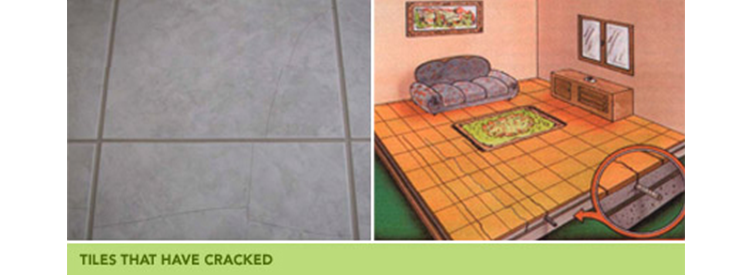
Whenever people see cracks in their tiles, they immediately assume that the tiles are faulty. In reality, tiles are a solid, inflexible flooring and any cracks appearing are a reaction to another cause. If your cracks are running across several tiles in what appears to be lines, read on. If the cracks appear to be more random, refer to another section of the Tile Doctor.
Cracks that run in lines across several tiles are due to movement in the substrate. There are structural problems that need attending to. Sure, you could cover the floor with vinyl or carpet and hide the symptoms, but there is still an issue that needs to be fixed.
• Excessive movement in the substrate will cause a crack in the tiled surface that runs through several tiles in a roughly straight line.
• If the tiles are laid over a slab of concrete and a crack appears in the tiled surface, then that slab is moving and there is a structural issue.
• If the crack occurs at the meeting point between two slabs that were laid at different times, then there should be an expansion or movement joint at that junction in the substrate. Cracking here is due to that movement or expansion joint being carried through the tiles.
• If the cracking occurs along the junction of two different surfaces, such as where a timber floor and a concrete floor meet, a movement joint is necessary and must be extended through to the surface of the tiles.
• The concrete has not been left to cure for sufficient time (1 month per 25mm of slab thickness), or a suitable flexible adhesive has not been used. Shrinkage cracks in the concrete have transferred through the tiles.
• Another cause could be 'foundation rod stress' that can manifest itself during settling and curing of the concrete. This can cause superficial cracking in the concrete. If the tiles were laid without suitable flexible adhesive, the cracking can also appear in the tiles. Keep in mind that even when a flexible adhesive is used, the cracking, shrinkage, or movement can be more than that which the adhesive can compensate.
Firstly, it needs to be determined if the cracking is only superficial and due to the slab shrinking and curing, or if there are structural issues, or if movement joints were not extended to the surface through the tiling.
If the substrate cracking is superficial, and the concrete slab new, then the tiler has undoubtedly not used suitable flexible adhesives. The tiles should be replaced and correct adhesives used. If the expansion joints were not brought to the surface of the tiles, then that will need to be corrected.
The damaged tiles need to be replaced and movement joints extended to the surface. This is also the case if the concrete slab was old, but had obvious established cracks of 2mm or wider and the tiler did not make allowance for this movement.